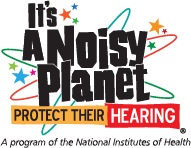It’s a Noisy Planet. Protect Their Hearing.® is a national public education campaign aimed at preteens (children ages 8 to 12), their parents, and other educators with the goal of increasing awareness of the causes and prevention of noise-induced hearing loss.
The science-based program was developed by the National Institute on Deafness and Other Communication Disorders (NIDCD), part of the National Institutes of Health (NIH). Research shows that parents and caregivers are the primary influence on this age group. With Noisy Planet tools and information, parents and other adults can encourage children to adopt healthy hearing habits before and during the time that they develop listening, leisure, and working habits. Noisy Planet’s three key preventions messages are:
Fast Facts
- Analysis from a nationally representative health interview and examination survey found that nearly one in four (24 percent) of U.S. adults aged 20 to 69 years has features of his or her hearing test in one or both ears that suggest noise-induced hearing loss (NIHL).1
- One in eight people in the United States (13 percent, or 30 million) aged 12 years or older has hearing loss in both ears.2
- Preventable. We can help our children avoid hearing loss caused by noise.
- Sounds at or below 70 A-weighted decibels (dBA) are generally considered safe.
- 85 dBA: Prolonged or repeated noise at this level puts you at risk for hearing loss.
Hearing Loss Caused by Loud Sounds
- Symptoms of hearing loss from noise increase gradually. Over time, the sounds a person hears may become unclear, making it hard to understand what people are saying. Someone with hearing loss caused by noise may not even be aware of the loss.
- Hearing tests can uncover hearing loss caused by noise.
Risk Factors
- Noise-induced hearing loss is related to:
- How loud the sound is (the decibel level),
- The amount of time you are exposed to the sound, and
- How far away you are from the sound.
- Hearing loss from noise is related to a person's genes. Some people are more likely than others to harm their hearing when they listen to certain sounds. Scientists are working to figure out which people are more at risk for this type of hearing loss.
- You may not realize it, but some common activities that children participate in can reach potentially damaging noise levels: playing band instruments; listening to music or watching television set at high volumes; attending concerts and movies; playing with loud toys; and riding off-road vehicles and snowmobiles.
How Hearing Loss Happens
To understand how loud noises can damage our hearing, we have to understand how we hear. Hearing depends on a series of complex steps that change sound waves in the air into electrical signals. The auditory nerve then carries these signals to the brain for us to understand. Learn how sounds make their way from the source to your brain with this video and check out the How We Hear fact sheet.
Noise-induced hearing loss happens when tiny hair-like structures (stereocilia) that sit on top of hair cells in the inner ear are damaged by noises that are too loud and/or last for too long. When stereocilia are damaged, the hair cells can’t send information about the sound to the brain. This leads to noise-induced hearing loss. This type of hearing loss is permanent.
Additional Quick Statistics on Hearing, Ear Infections, and Deafness can be found on the NIDCD website.
Sources
- Carroll YI, Eichwald J, Scinicariello F, et al. Vital Signs: Noise-Induced Hearing Loss Among Adults—United States 2011–2012. MMWR Morb Mortal Wkly Rep 2017;66:139–144.
- Lin FR, Niparko JK, Ferrucci L. Hearing loss prevalence in the United States. [Letter] Arch Intern Med. 2011 Nov 14; 171(20): 1851–1852.



